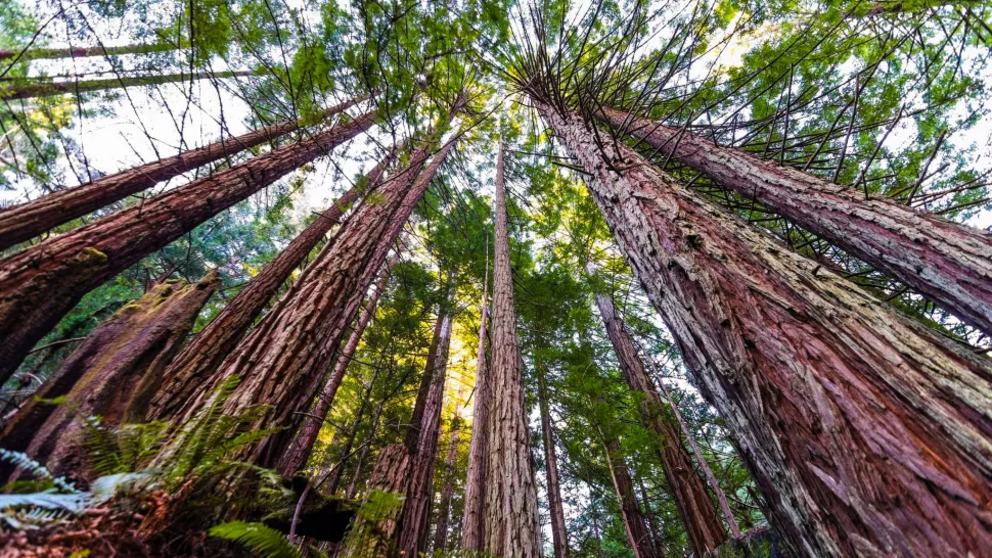What is the world's tallest tree?
The tallest trees on Earth live in California. These towering coastal redwoods (Sequoia sempervirens), shown here in the Purisima Creek Redwoods Preserve, Santa Cruz Mountains, can live for hundreds of years.
Hyperion, which looms above the lost coast of Northern California, is the world's tallest tree.
Trees are some of the most majestic and awe-inspiring living things on the planet. And many of them are really, really big.
But which one is the tallest?
It turns out that the tallest trees on Earth are the coast redwoods (Sequoia sempervirens) that loom over the mist-shrouded coastline of Redwood National Park, in Northern California. And the king of these giants is a tree known as Hyperion, according to Guinness World Records (opens in new tab). When it was last measured in 2019, it stood an eye-popping 380 feet, 9.7 inches (116.07 meters) tall from top to base, taller than a 35-story building.
Hyperion's exact location is a closely held secret, but it is apparently rooted in a hillside in which most of the old-growth coastal redwoods have been logged. Somehow, Hyperion has escaped the chainsaw, and the tree is estimated to be between 600 and 800 years old.
The living skyscraper was first discovered in 2006, by Chris Atkins and Michael Taylor, part of a team of researchers who, at the time, tramped through the California forests hunting for the tallest trees, SFGate reported (opens in new tab). At that time, the tree was a tiny bit shorter, at 379 feet, 1.2 in (115.5 m). Around the same time, that group discovered the second and third-tallest trees: Helios, which was then 376.3 feet (114.7 m) tall, and Icarus, which stood 371.2 feet (113.1 m) tall.
"Even though they're on steep slopes, they're growing in the finest redwood habitat on the planet," Atkins told SFGate in 2006. "They're right below a ridge, so they're protected from the wind. They're near abundant water, and they have plenty of fog, which keeps the local microclimate mild and moist. And they have great sun exposure."
Coast redwoods are not only the tallest trees on the planet, they are also some of the oldest living things on Earth; they can live up to 2,000 years. It's not clear exactly why these trees can live to be so ancient, but the climate plays a role. Even when inland California burns in the summer, a blanket of thick fog enshrouds the coastal groves, keeping the temperature cool year-round. The coast also sees about 100 inches (254 centimeters) of rainfall a year, which also helps nurture these groves of giants, according to the National Park Service (opens in new tab).
Coast redwoods are also some of the most resilient trees on Earth. Their tannin-rich bark seems to be nearly impervious to the fungus and disease that fells other trees, according to the NPS. And the 12-inch-thick (25 cm) bark of these silent giants enables them to withstand the wildfires that have historically swept through the Sierras.
While coast redwoods are the tallest trees on Earth, they are not the largest. The largest trees on the planet are General Sherman and General Grant, giant sequoias that cling to the rocky, fire-scarred Sierras in California's Kings Canyon and Sequoia National Parks.
And North America doesn't have a monopoly on uber-tall trees. The tallest trees on other continents, according to Guinness World Records, are:
- A Eucalyptus regnans found on the island of Tasmania, which stands 327.5 feet (99.82 m) tall, is Australia's tallest tree.
- Asia's tallest tree is a yellow meranti tree (Shorea faguetiana) found in Malaysia. It is just a touch shorter than Australia's tallest tree, at 323.3 feet (98.53 m) tall.
- In South America, a red angelim (Dinizia excelsea) tree in Brazil's Amazon rainforest is the tallest on the continent, at 290.4 feet (88.5 m)
- Africa's tallest tree, a myovo tree (Entandrophragma excelsum) near Kilimanjaro National Park in Tanzania stands 267.4 feet (81.50m) tall
- Europe's largest tree lives in Portugal. This Karri tree (Eucalyptus diversicolor) stands 239.2 feet (72.9 m) tall.
Originally published on Live Science.

